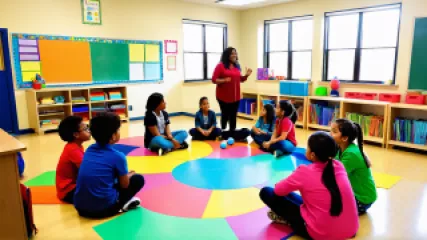How to Support the Mental Health of School-Age Children
How to Support the Mental Health of School-Age Children
As parents, educators, and members of the community, we have a responsibility to ensure the well-being of our school-age children. Mental health is a critical aspect of a child's overall development, and it is essential that we provide the necessary support and resources to help them navigate the challenges they face. In this comprehensive guide, we will explore practical strategies and evidence-based approaches to supporting the mental health of school-age children.
Understanding the Importance of Mental Health in School-Age Children
Mental health is a crucial component of a child's overall well-being, influencing their cognitive, emotional, and social development. During the school-age years, children undergo significant changes and face a variety of stressors, including academic demands, peer relationships, and the ongoing process of self-discovery. Addressing their mental health needs is crucial, as it can have long-lasting implications on their future success and happiness.
Research has shown that children with strong mental health are better equipped to cope with stress, build positive relationships, and achieve academic and personal goals. Conversely, unaddressed mental health issues can lead to a range of problems, such as behavioral challenges, academic difficulties, and even the development of more serious mental health conditions in adulthood.
Recognizing the Signs of Mental Health Concerns in School-Age Children
Identifying the signs of mental health concerns in school-age children is the first step in providing the necessary support. Some common indicators may include:
- Changes in mood or behavior, such as increased irritability, sadness, or withdrawal from social activities
- Difficulty concentrating or paying attention in the classroom
- Unexplained physical symptoms, such as headaches or stomach aches
- Changes in sleep patterns, such as difficulty falling asleep or staying asleep
- Significant changes in appetite, either a decrease or increase
- Expressed feelings of worthlessness, hopelessness, or suicidal thoughts
It is important to note that these signs may vary from child to child, and it is essential to observe patterns and changes over time rather than relying on a single indicator. If you notice any of these signs, it is crucial to address them promptly and seek professional help if necessary.
Promoting Positive Mental Health Practices at Home
As parents and caregivers, we play a vital role in supporting the mental health of school-age children. Here are some strategies to implement at home:
Fostering Open Communication
Encourage your child to express their thoughts, feelings, and concerns openly. Create a safe and non-judgmental environment where they feel comfortable sharing their experiences. Listen actively, validate their emotions, and avoid minimizing or dismissing their concerns.
Establishing Routines and Consistency
Maintaining a predictable daily routine can help children feel secure and grounded. This includes consistent bedtimes, mealtimes, and time for schoolwork, play, and rest. Consistency in rules and expectations can also contribute to a child's sense of stability and well-being.
Promoting Healthy Habits
Encourage your child to engage in regular physical activity, get adequate sleep, and maintain a balanced diet. These healthy habits can have a positive impact on their mental health, providing them with the energy and resilience needed to navigate challenges.
Prioritizing Quality Family Time
Carve out dedicated time to engage in activities that are meaningful and enjoyable for your family. This could include game nights, outdoor adventures, or simply spending quality time together. These moments of connection and bonding can foster a sense of belonging and security in your child.
Modeling Healthy Coping Strategies
Teach your child effective ways to manage stress, such as deep breathing, mindfulness practices, and healthy self-expression. Model these strategies yourself, demonstrating how to healthily process and navigate difficult emotions.
Collaborating with School Professionals
School is a significant part of a child's life, and collaboration between parents and school professionals is crucial for supporting their mental health. Here are some ways to work together:
Open Communication with Teachers and Counselors
Maintain regular communication with your child's teachers and school counselors. Share any relevant information about your child's mental health, and work together to develop strategies that can be implemented both at home and at school.
Accessing School-Based Mental Health Services
Many schools now offer on-site mental health services, such as counseling, therapy, and support groups. Familiarize yourself with the resources available and encourage your child to take advantage of these services if needed.
Advocating for Accommodations and Interventions
If your child is struggling with mental health-related challenges that are impacting their academic performance, work with the school to explore accommodations or interventions that can help. This may include extended deadlines, modified assignments, or access to a quiet space for breaks.
Seeking Professional Support
In some cases, additional professional support may be necessary to address more complex mental health concerns. Consider the following options:
Consulting with a Child Psychologist or Therapist
A qualified mental health professional, such as a child psychologist or licensed therapist, can provide comprehensive assessment, diagnosis, and personalized treatment plans to address your child's specific needs. They can work with you and your child to develop coping strategies, address underlying issues, and promote overall well-being.
Exploring Behavioral Therapy
Behavioral therapy, such as cognitive-behavioral therapy (CBT) or dialectical behavior therapy (DBT), can be particularly effective in helping school-age children develop healthy coping mechanisms, regulate their emotions, and improve their overall functioning.
Considering Medication, if Necessary
In some cases, medication may be prescribed by a child psychiatrist or pediatrician to address specific mental health conditions, such as anxiety or depression. This should always be done in close consultation with a medical professional and as part of a comprehensive treatment plan.
Fostering a Supportive Community
The mental health of school-age children is not solely the responsibility of parents and educators; it takes a village. By creating a supportive community, we can collectively ensure that our children have the resources and support they need to thrive.
Engaging with Local Resources
Familiarize yourself with local mental health organizations, support groups, and community programs that cater to the needs of school-age children and their families. These resources can provide valuable information, referrals, and opportunities for connection and support.
Advocating for Mental Health Awareness and Education
Become an advocate for mental health awareness and education within your child's school and community. Collaborate with school administrators, PTAs, and local organizations to organize workshops, guest speakers, and educational campaigns that destigmatize mental health and empower children, parents, and educators to prioritize well-being.
Fostering a Culture of Empathy and Inclusion
Encourage your child's school and community to create an environment that is inclusive, accepting, and supportive of children with diverse mental health needs. Foster a culture of empathy, understanding, and acceptance, where all children feel valued and supported.
Conclusion
Supporting the mental health of school-age children is a multifaceted endeavor that requires the collective effort of parents, educators, and the broader community. By implementing the strategies outlined in this guide, we can empower our children to navigate the challenges they face, build resilience, and thrive both academically and personally.
Remember, mental health is not just about addressing problems; it's about promoting overall well-being and nurturing the social, emotional, and cognitive development of our children. By prioritizing their mental health, we are investing in the future of our communities and ensuring that every child has the opportunity to reach their full potential.
Let us work together to create a world where school-age children feel supported, understood, and empowered to take charge of their mental health. Through our collective efforts, we can make a lasting difference in the lives of our children and secure a brighter future for all.






